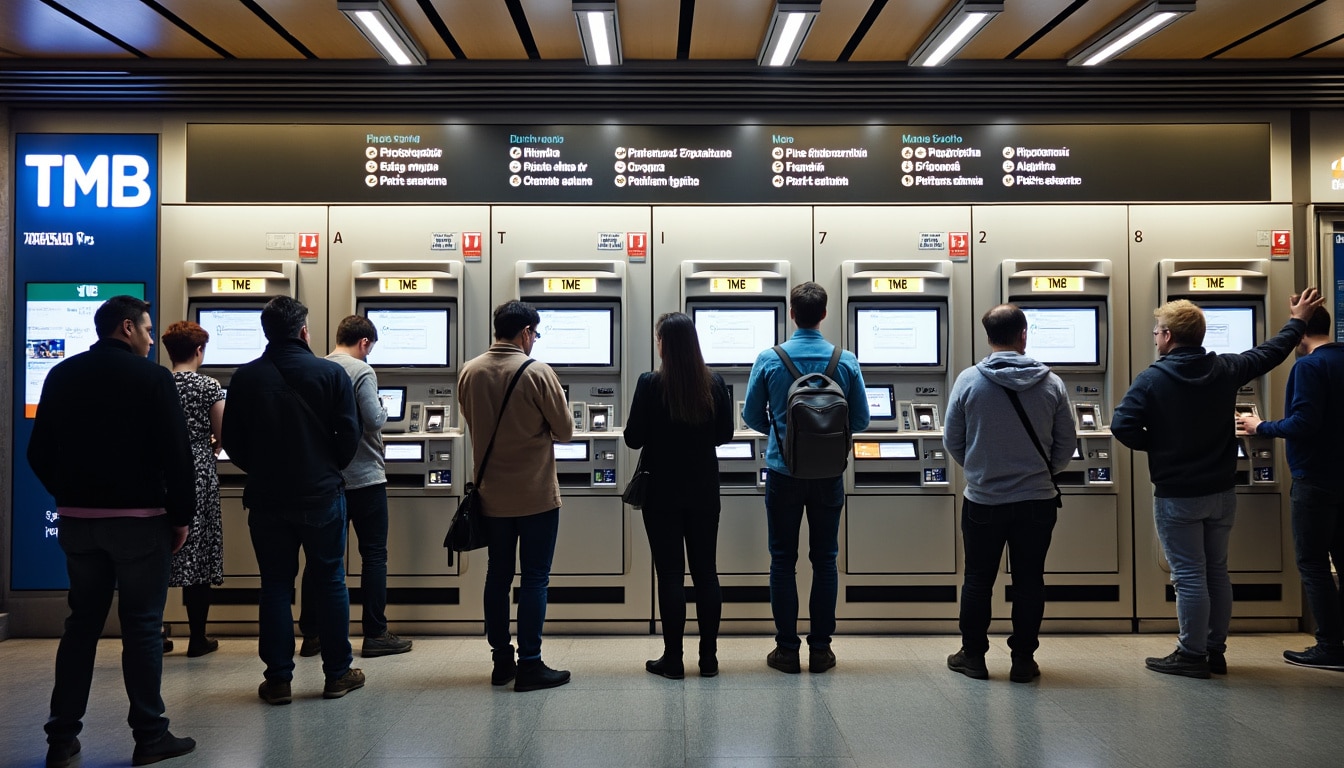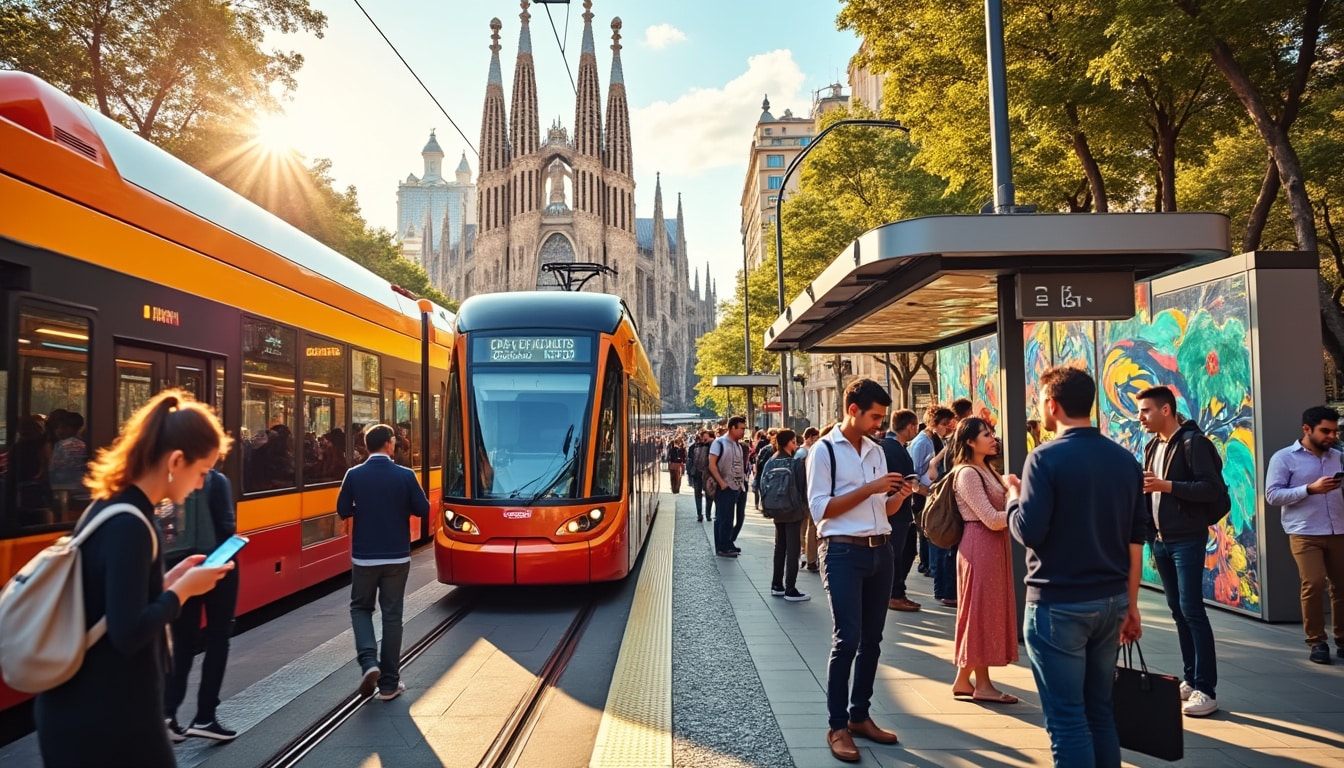Barcelona, a vibrant city known for its architecture, rich history, and cultural heritage, also boasts a modern and efficient public transportation network. Whether it’s the expansive metro network or the multiple bus routes that zigzag through the city, Barcelona caters to both its million residents and the tourists who flock to admire Gaudí’s masterpieces. With services like the TMB, Ferrocarrils de la Generalitat de Catalunya, and Rodalies de Catalunya, traveling within and beyond the city has never been simpler. Plus, the introduction of contactless payment systems and the T-mobilitat ensures seamless travel experiences. In 2025, these conveniences are essential, evolving to better serve a city bustling with life and activity.
Barcelona Metro: Navigating the City’s Underground Network
The Barcelona Metro, operated by the Transports Metropolitans de Barcelona (TMB), is arguably the most efficient way to get from one point to another. The network is composed of 8 lines, with neatly color-coded paths covering the city and extending to its outskirts, offering an intricate web of routes.
Navigating the metro can be a breeze, once adventurers grasp the basic rules. First-time users should look for the distinctive red and white ‘M’ signage, which designates metro stations scattered throughout the city—these can be easily spotted from a distance. Ticket vending machines, conveniently found at every metro entrance, offer multi-language options, ensuring tourists and non-Catalan speakers feel right at home.
- Metro trains run every 2-6 minutes during peak hours, ensuring you never have to wait long. 🚆
- Lines like the Red Line (L1) are tourist favorites, with stops at hotspots such as Arc de Triomf and Plaça de Catalunya. 🏛️
- For football fans, the Blue Line (L5) takes you directly to Camp Nou, the hallowed ground of FC Barcelona. ⚽
Accessibility is another highlight of the Barcelona Metro. As of 2025, continuous improvements have made almost all stations reachable for users with reduced mobility, ensuring inclusivity for all passengers. Another boon for travelers is the digital advantage: city explorers can use apps like Citymapper to plot their journeys, with real-time updates on the fastest and most direct routes.
One innovative feature is the synchronized ticketing system shared across metros, buses, and trams. The T-Casual card allows for multiple rides across all transport forms, an economical choice for both short-term visitors and residents making frequent trips. And for those eager to delve into the cultural heartbeat of Barcelona, the Hola Barcelona Travel Card provides unlimited daily rides, including airport transfers, making it a cost-effective option for a hassle-free adventure.

Transit Tips for Your Metro Journey
For an optimal metro experience, here are some practical tips:
- Always keep an eye on your belongings, especially during peak hours when crowds can be overwhelming—a remarkable safety tip to navigate Barcelona securely.
- If visiting iconic landmarks like the Sagrada familia, consider traveling outside of peak hours to avoid long queues and crowded trains.
- Using a combination of T-Casual cards and the Hola BCN! passes can maximize transit savings, especially if staying in Barcelona for several days.
Ultimately, the city’s metro is not simply a mode of transport. It’s a part of the Barcelona experience, connecting travelers to both well-trodden paths and hidden gems in this remarkable city. For more helpful tips on planning the optimal length of stay in Barcelona to take the most advantage of the extensive transport network, visit this detailed guide.
Exploring Barcelona by Bus: A Mobile Panorama
Buses, orchestrated by the same TMB that manages the metro system, offer an alternative narrative of Barcelona’s charm. While the metro tunnels below, the city’s buses roam through vibrant neighborhoods, allowing travelers to experience the environment of the city’s streets.
The key to bus services is their extensive reach. They cater to every corner of Barcelona, even places the metro might not serve efficiently. Bus routes like Nitbus ensure nocturnal adventurers have safe passage across the city in the late hours, offering 17 distinctive overnight routes.
- Single bus tickets cost €2.55, the same as a metro trip, but consider investing in a T-Casual card for more economical travel. 🚍💳
- Routes such as Line 59 drop passengers at Plaça Reial in the heart of the Gothic Quarter, an excellent start for a self-guided tour of medieval streets. 🏰
- Aerobus services bridge the two city terminals and central spots like Plaça de Catalunya, though at a slightly elevated cost of €12.25 round trip compared to regular fares. 🛫🚌
One might worry about navigating this extensive bus network, yet resources like the TMB website offer comprehensive guides. Real-time schedules uphold Barcelona’s aim of offering simple, accessible transport to all. What’s more, contactless payment systems have eased the process, integrating seamlessly with existing modes, if expectations lean towards a cashless journey.
Despite facing higher traffic compared to the metro, buses provide a flexible and leisurely way to explore Barcelona. Nature lovers can head to Montjuïc using Line D40, accessing hidden green spaces and outstanding vistas of the Mediterranean.
Insider Bus Tips When Navigating Barcelona
Enhance your bus ventures with these useful tips:
- Avoid peak travel times to ensure a relaxed journey and avoid Barcelona’s notorious rush-hour traffic.
- Always have small change or a contactless card ready. Although buses accept cash, bus drivers might decline large bills.
- Plan your routes and transitions with assistance from Citymapper for up-to-date, accurate next-stop information.
When planning your budget, consider the comparative prices of various transport modes in Barca by checking out this comprehensive pricing guide for a detailed overview.
Trains and Trams: Exploring Beyond Central Barcelona
Barcelona’s train and tram systems offer long-distance travel options into suburban areas and beyond. Primary providers, the Ferrocarrils de la Generalitat de Catalunya and Rodalies de Catalunya, facilitate an intersecting network that promises efficiency and consistency.
Trains serve as a gateway beyond the core city area. Destinations like Montserrat, an hour from the hustle and bustle, are accessible by train. The Rodalies service guarantees safe journeys to iconic mountain retreats like this sacred site.
- Lorem: €8.95/Adults 🎟️
- Rodalies’s direct link to terrestrial wonders like the Castell de Torre Baró for afternoon adventures. 🏰
- Transition smoothly with a valid T-Casual or Hola BCN card on these suburban routes. 🎫
Trams, on the other hand, cater to more localized travel needs, especially in western and eastern halves of the city. With networks like Trambaix and Trambesós, they enable visits to distinctive quarters easily accessible by this graceful, modern mode.
Representing the historic aspect, Tramvia Blau takes riders through streets adorned with Modernista houses, climbing to the foot of Tibidabo Mountain—a route that is as much about the journey as it is about the destination.
Train and Tram Ride Tips for Adventurers
Train and tram journeys are enriched with these mindful considerations:
- For countryside seekers, trains like those to Montserrat offer a tranquil, scenic escape beyond the cityscape.
- Avoid rush hours to enjoy uninterrupted views through tram windows, particularly on the picturesque Tramvia Blau line.
- Engage with locals to gather tips and insights about must-visit spots along your journey.
Connectivity to sites such as Montjuïc adds to the appeal of Barcelona’s trains and trams. To better understand the transport system, visit this detailed trip planning guide.
Alternative Transport: Initiatives at the Heart of Barcelona
In 2025, as urban mobility evolves, Barcelona embraces alternatives like Bicing, a forward-thinking bike-sharing program. Such initiatives symbolize a greener future, allowing seamless integrations of individual journeys within public networks.
Bicing has bikes available across the city, both electric and mechanical—an enticing way to combine fitness with commuting. With docking stations positioned strategically around metro and bus stops, switching between bikes and public transport is incredibly convenient.
- Lock your bike appropriately to avoid theft—download the dedicated Bicing app for additional security tips on the go. 🚴♀️🔒
- Consider Bicing’s extensive network when planning routes, with stations available near popular hubs like Barceloneta Beach. 🌊🚲
- Look for routes incorporating landmarks such as the art-laden streets of the Gothic Quarter or the expansive avenues in Eixample. 🎨
Along with Bicing, Barcelona implements flexible payment methods like the T-mobilitat, ensuring a cashless journey with contactless solutions at the forefront of development. Such systems alleviate the need for physical money, aligning perfectly with broader European trends toward streamlined, digital transitions.
The Hola Barcelona Travel Card, also known as Hola BCN!, stands out as a tourist favorite. It offers travelers unlimited public transport access. Inclusive of airport transfers, this travel companion provides great value, perfect for wanderlusters eager to explore both familiar highlights and less-explored areas. Check more about Barcelona currency and payments for travelers on this insightful page.
Maximizing Your Barcelona Transport Experience
For an enriched, hassle-free day-to-day journey, bear these strategies in mind:
- Use the Citymapper app for real-time updates on bus and train schedules, ensuring smooth transitions between vehicles.
- Capitalize on off-peak times to enjoy a quieter, more relaxed ride, particularly when aimlessly exploring architectural marvels or picturesque boulevards.
- Tap into community wisdom by participating in local tours or forums, gaining insights from fellow travelers or seasoned locals.
If you’re planning an extended stay, it’s worth exploring when the cheapest time to visit Barcelona is to coincide with the most tranquil and economical travel periods. For more tips on long-term planning and cost-saving measures, consider visiting this page.
FAQ: Navigating Public Transport in Barcelona
- What is the most effective travel pass for tourists? The Hola Barcelona Card offers unlimited rides on public transport, including the metro, buses, and trams, ideal for tourists seeking extensive exploration.
- Can I use ticket cards interchangeably across different transport modes? Yes, the T-Casual and Hola Barcelona Travel Cards are valid for metro, buses, trams, and suburban trains offering seamless transitions.
- Is it easy to reach Barcelona Airport using public transport? Absolutely. Metro offers direct access, and the Aerobus services provide regular shuttles, while valid travel cards cover airport stations.
Whether for a weekend sojourn or a longer stay, Barcelona’s interconnected networks promise both convenience and diversity, truly reflecting the city’s vibrant pulse.

